From Theory to Practice: A Jigsaw Approach to an Elementary Master Schedule

Jigsaw Puzzle: Creating a highly collaborative school culture and high performing teams is multifaceted and can take many years to establish. Whether you are a seasoned or novice leader, creating and maintaining a system of excellence is a hard job! Schools do not become great overnight and they certainly do not remain great without constant evaluation of systems and practices. The fundamental purpose of a school is learning, not teaching. However, you cannot learn without high quality instruction. A priority of any campus leader must be to ensure high levels of learning for all kids, every day. A systematic approach to master scheduling can be viewed as a gigantic jigsaw puzzle that captures a clear picture of equity, collaboration, and ensuring high levels of learning for all students. At the secondary level, a master schedule is simply imperative to ensure all students receive a class schedule on the first day of school; however, is this the standard on an elementary campus? Elementary schools typically have self-contained or teamed classrooms, which can easily lend everyone to run on individual schedules. Furthermore, a master schedule can easily be viewed as an incomplete puzzle; pieces of a puzzle lying in a box. Every elementary campus runs on some sort of a schedule; the question is does your master schedule run the school or does the school run the master schedule?
Staff Buy In: A systematic master schedule is the foundation for all instructional decisions made by campus leadership, coaches, interventionists, and teachers. When categorizing tight and loose systems, a systemwide master schedule falls under a tight system, simply because everyone in the organization must work from the same framework in order to meet the needs of all students. What are the limitations in schools where the school is running the master schedule? One limitation may be staff buy in. Douglas Reeves categorizes decision making in these three categories: “health, safety, and values.” This can be summarized quite simply: a leader will make a quick decision should the solution impact the health and safety of the students or staff, or the values of the school positively or negatively. A systematic master schedule could be a campus system that needs change but the leader is waiting for buy-in; however, “courageous leaders do not seek consensus or buy-in on essential issues that are fundamentally related to the values of their organization. Rather they require implementation, even when consensus and buy-in remain elusive (Reeves, 2016, p. 94).” Building a master schedule that an entire school works from ensures you are providing equity to all students and should not be something we wait for everyone to buy-in to. In terms of health, safety, and values, if it is good enough for one student it should be good enough for all.
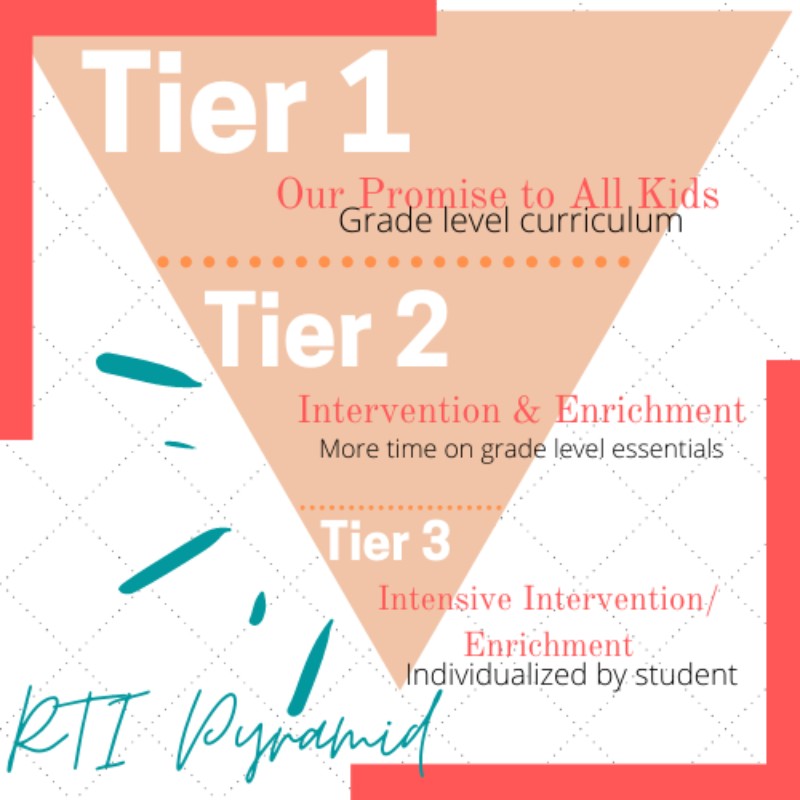
Providing equity to all students: Based on the conceptual framework called Response to Intervention, schools offer three tiers of instruction to ensure all students have access to the learning they need to grow a minimum of one year. “We should also think of RTI as response to instruction, or RTI² (response to instruction and intervention). Rather than waiting until students fail the summative tests and then sending them to Tier 2 intervention, what about finding out which students need additional time and support before they fail? (Buffman, Mattos, Malone, 2018, p. 122).” A systemwide master schedule ensures all students have access to all tiers of instruction each day. (see picture 2) “It is disingenuous for any school to claim its purpose is to help all students learn at high levels and then fail to create a system of interventions to give struggling learners additional time and support for learning. If time and support remain constant in schools, learning will always be the variable (DuFour, DuFour, Eaker Many, 2006, p. 78).”
- Tier 1 instruction is grade level instruction that all students receive. Think of this tier as a promise to every student. The adults in the building are committed to ensuring every student is given the opportunity to learn what has been identified as a Tier 1 essential curriculum utilizing district resources and state standards.
- Tier 2 intervention & enrichment is extra time to master grade level curriculum. This is the “bonus hour” for our essential standards. Students who need more time to master the essential standard in math or reading will be given an opportunity to receive intervention on a specific learning target that needs more practice. In addition, this time can also be seen as an enrichment block for those students who showed mastery of the essential standard.
- Tier 3 intervention is a specialized intervention to fill gaps from previous years or an enrichment program, such as Gifted and Talented (GT).
From Practice to Logistics
Getting Started: Prior to creating the master schedule, the principal collaborates with an instructional team of campus instructional coaches, interventionists, and teachers to gather ‘feedback to consider.’ Consider creating a form to generate feedback from teachers with questions such as: “What worked well with the schedule you had last year?”, “What part of your instructional schedule did not work well?”, “Did your students benefit from the instructional blocks or is there a block that is too choppy or too long?” This information may be found by accessing the Campus Needs Assessment. If a campus discovers a trend in lower reading scores, a campus may write a SMART goal to address this need. Possible leads to focus on would be adding a Tier 2 reading block into the master schedule, or ensuring students who are identified as Tier 3 are not missing Tier 1 or Tier 2 instruction. Teacher feedback is important to consider before building the master schedule; however, the end goal is a completed jigsaw puzzle, not a box of jigsaw puzzle pieces. Therefore, not all feedback will be applied depending on the overall needs of the building. Building a systemwide master schedule is much like the writing process; you begin with brainstorming your ideas on paper, drafting on sticky notes, revising by manipulating and changing, and eventually publishing it into a virtual document that is available to your entire campus. This final document is what drives every instructional decision.
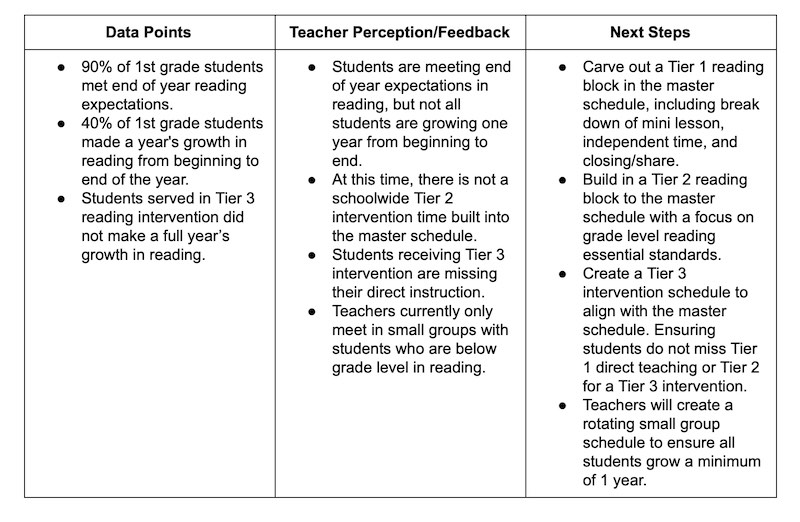


Aligning Class Lists with your Master Schedule: A key component to a successful systemwide master schedule is ensuring your class lists align with the master schedule. To ensure students are placed appropriately, you will want to gather rosters for special populations. In addition, you will want to think about any student who is in the process of special education testing, dyslexia testing, GT testing, etc… and how the conclusion of their assessment could impact their class placement. Color coding your class lists according to their intervention will help assist when placing students appropriately. Rosters to consider gathering are included below:
- Dyslexia students with their group level
- ESL students
- Gifted & Talented students
- Special Education students
- Tier 3 math and reading intervention groups
One way to ensure high levels of learning for all kids is to ensure each student in your building receives Tier 1 instruction in all content areas everyday. Tier 2 intervention/enrichment is built into the daily schedule. Tier 3 schedules are built by the master scheduler, and not in isolation by each interventionist, to ensure intervention does not overlap with Tier 1 or Tier 2 instruction, or coincide with another Tier 3 intervention. Students are placed in a homeroom class based on the master schedule. Tier 3 intervention schedules will not overlap if the master schedule is used to create those intervention times and pull-out groups.
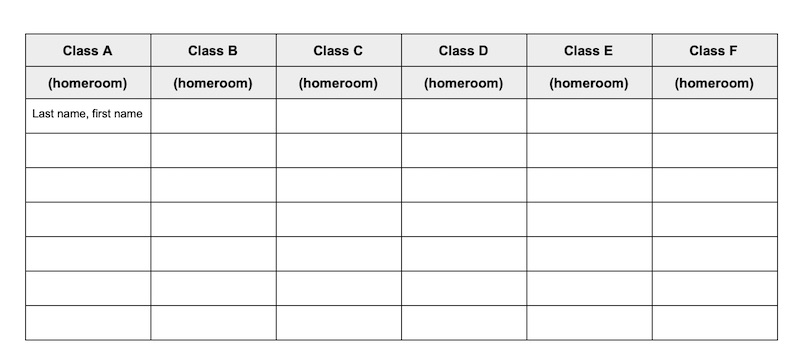
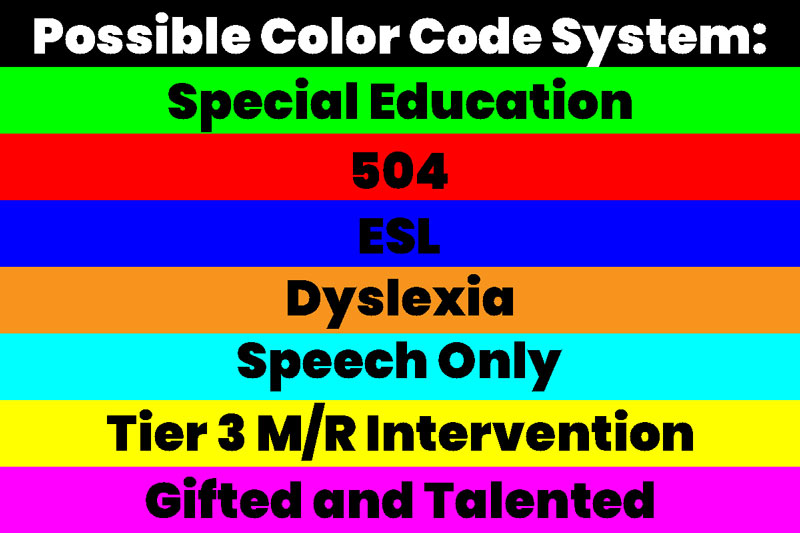
Let’s Focus In
A 3rd grade group of dyslexia students are in year one of the district identified dyslexia program. According to the master schedule, the 3rd grade reading mini lesson starts at 8:10 AM. The dyslexia intervention will begin at 8:20 AM each day. This pull out time ensures this particular group of students are receiving their Tier 1 grade level curriculum. If students missed their direct teach each day for dyslexia, they would miss 50 minutes of direct reading instruction per week. Since 3rd grade is a departmentalized grade, these students can either all be placed in the same language arts homeroom or spread out in different language arts homerooms.
A 2nd grade inclusion class has five students identified as special education students. The students each have their own schedule of services. The schedule of services are met by special education teachers and paraprofessional support. Students are taught in the inclusion model; allowing the general education and special education teachers the accessibility to co-teach in order to provide adequate accommodations and support to all students.
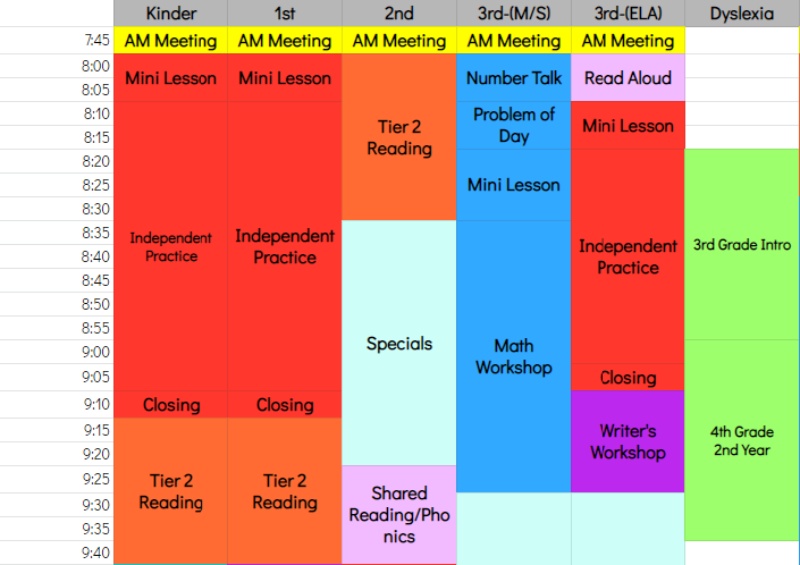
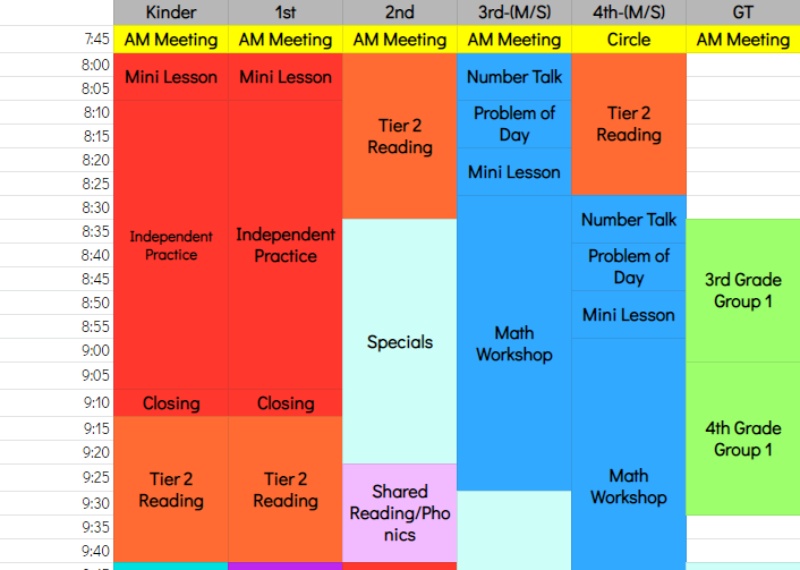
GT students receive a designated amount of minutes of Tier 3 enrichment instruction each week. This quantity is determined by district or campus expectations. In this scenario, students receive 150 of GT minutes per week. Students are pulled from their math and science instructional blocks in order to receive their gifted and talented minutes. When building the GT pull out schedule, first we must identify when each grade level is teaching math and science. The GT pull out blocks are created around these content blocks. Interventionists can have a rotating schedule which allows students to not be pulled from the same content each day.
A campus who runs a resource room to meet identified special education minutes would use the master schedule to create the pull out groups. In a resource classroom, there can be multiple grade levels at one time. When creating pull out times, the person creating the schedule must ensure students are not pulled from their Tier 1 direct teach, or the built in Tier 2 time. Students should receive their special education minutes during their Tier 1 independent time.
Take a look at the Tier 3 Reproducible from earlier in the article. Now that you have outlined each Tier 3 intervention on your campus, take a moment to sequence these interventions by priority. This will help guide you as you make those tough decisions about which Tier 3 intervention takes priority over another. Another thing to consider is your Campus Needs Assessment and the goals outlined based on this data.
Leveraging the Master Schedule for a Framework of Productivity
- Carve out time for Tier 1 instruction by utilizing district recommendations or by following the general recommendations below:
- Reading block- 60 minutes/day
- Writing block- 60 minutes/day
- Other language components- 25 minutes/day
- Math block- 90 minutes/day
- Science/Social Studies block- 30 minutes/day
- Create a Tier 1 small group schedule that ensures all students are being instructed in small groups during the heart of the workshop or independent time. See sample 1st grade reading small group schedule below.
- Build in time for Tier 2 intervention/enrichment and create campus assessment practices to monitor who needs more time at Tier 2 on grade level essentials.
- Reading intervention/enrichment- 30 minutes/day
- Math intervention/enrichment- 30 minutes/day
- Allowing for a systematic Tier 3 intervention approach
- Intervention schedules may rotate Monday-Friday depending on group needs; some groups may need 3 days of intervention/week where others may need 4-5 days of intervention per week.
- Time for tier 3 intervention is dependent on the student’s schedule of services according to their IEP, the recommended minutes per week for the specific Tier 3 intervention. Additionally, tier 3 reading and math intervention with a specialist, is dependent on the student’s SMART goal. However, most tier 3 interventions are a minimum of 30 minutes/day, 3-times per week.
- The built in special areas time is designated for a block of time each day. During this time, students receive instruction in physical education, music, fine arts, computer, and library. Teachers are given time for instructional planning, data review, intervention planning, and a myriad of other important tasks. “Interdependence is what schools are all about. Productivity, performance, and innovation result from joint action, not just individualized efforts and behavior (Learning by Doing, 2006, 107).”
- Social-emotional health of students is a priority to developing a well-rounded student. Building in recess or extended brain break blocks will ensure all students have the opportunity to build out of classroom relationships with their peers and teachers.
- Once the systematic master schedule is created, teachers will have the autonomy to create flexible small group schedules during the designated independent time. This part of the schedule is flexible and should be tailored to the needs of each student and classroom. Teachers will monitor common assessment data to adjust groups based on need. The schedule sample below gives an idea of how a teacher would outline his/her small groups each week. The flexible schedule allows teachers to meet kids exactly where they are.
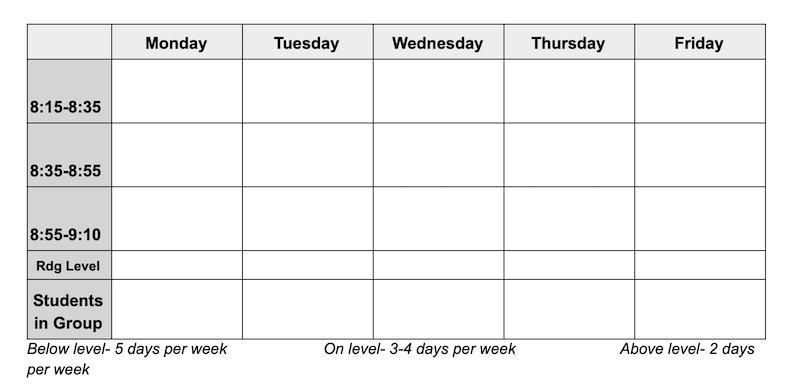
Master Schedule Pitfalls
- Each teacher planning their own schedule creates an environment that is not cohesive in collaboration and paints the picture that working in isolation is acceptable.
- Allowing the master schedule to be “loose” creates an environment that is not dependent on schoolwide tights to ensure equity for all students. In addition, Tier 3 intervention is dependent on the systemwide master schedule being followed. Therefore, students’ learning is compromised when the adults do not consider the master schedule a campus tight.
- Tier 2 intervention/enrichment time is optional creates an environment where the expectation for all kids to meet grade level standards is not the expectation.
- Overlapping Tier 2 and Tier 3 time doesn’t ensure all kids receive the appropriate tiers of instruction. Tier 2 is intended for additional time to master grade level essentials; not to receive a tier 3 intervention. If Tier 2 is replaced with Tier 3, the student is not receiving all three layers of the intended framework.
Where do we go from here?
The challenge confronting a systemwide master schedule lies in making significant changes and asking the question “What now are we prepared to do differently in order to maximize our instruction to meet the needs of all students at high levels?” Consider the following next steps to building a systematic master schedule:
- Identify the person who will create the master schedule.
- Gather ‘feedback to consider’ and identified instructional gaps/needs discovered through the Campus Needs Assessment. As mentioned earlier, the leader may have to make tough decisions, including going against teacher feedback.
- Sketch out 1) Schoolwide times 2) Extended blocks 3) Tier 2 time 4) Instructional blocks 5) Break down of instructional blocks
- Create a virtual document outlining every grade level’s schedule.
- Identify every Tier 3 intervention and complete the reproducible provided. When sequencing the priority of intervention, be sure to link it back to your Campus Needs Assessment.
- Develop a color coding system for class lists.
- Identify students enrolled in special populations.
- Create intervention schedules to align with master schedule & class lists.
- Train teachers to create small group schedules to align with Tier 1 independent time.
- Publish the master schedule schoolwide, including the break down of Tier 3 interventionists & support staff schedules.
This article is available and can be accessed in Spanish here.
DuFour, R., DuFour, R. B., Eaker, R. E., Many, T. W., & Mattos, M. (2020). Learning by doing: A handbook for professional learning communities at work. Bloomington, IN: Solution Tree Press.
Buffum, A. G., Mattos, M., & Malone, J. (2018). Taking action: A handbook for RTI at work. Bloomington, IN: Solution Tree Press.
Reeves, D. B. (2016). From leading to succeeding: The seven elements of effective leadership in education. Bloomington (IN): Solution Tree Press.









